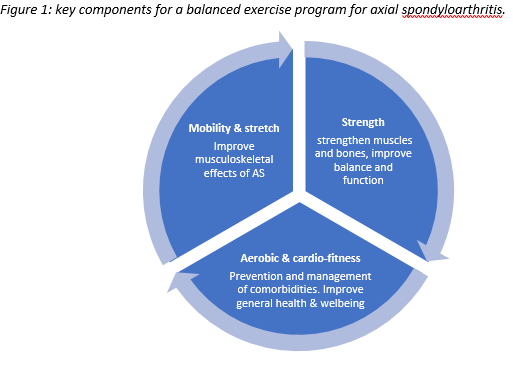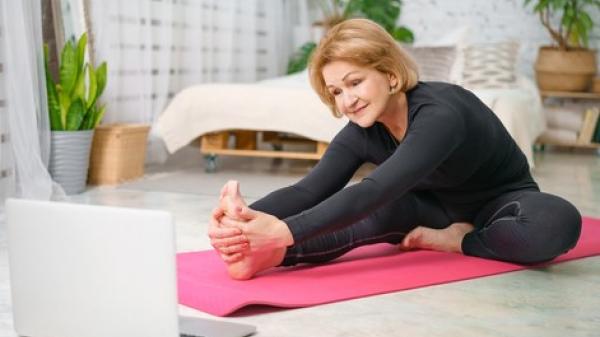
Physical activity and exercise are important for managing axial spondyloarthritis (axSpA). You may have noticed that your body feels better when you are moving and worse when you are keeping still. Keeping active can improve mobility and posture, muscle strength, balance and help maintain general health and fitness. It can also help to manage pain, fatigue (tiredness) and stress.
The best way to start and maintain an exercise routine is to speak with a physiotherapist. A physiotherapist will assess you and provide you with an individualised exercise program to suit your goals and treatment plan. Remember, exercise is not a case of ‘one size fits all’. Exercises to help you achieve your goals may not be the same for someone else.
It is important to always consult with a health professional before starting any new exercise.
The role of a physiotherapist
A physiotherapist is an allied health professional who is an expert in the structure of the human body and its movement. They will assess your current levels of pain, stiffness, strength, mobility, function, and fitness, and work with you to set goals and develop an exercise program appropriate for you. A physiotherapist will also provide you with education about your arthritis to help you understand it and help manage it.
You can receive up to five allied health sessions per year funded by Medicare. Your GP will need to refer you as part of a care plan. There are two types of care plans that can be prepared by a GP if you have a chronic disease, like arthritis. These are a GP Management Plan (GPMP) and Team Care Arrangement (TCA). Speak with your GP to find out more information.
What type of exercise are used in axSpA?
Exercises for axSpA should include a combination of mobility, strength, and aerobic. These types of exercises will help to address axSpA specific symptoms, like joint flexibility and range-of-motion. These types of exercises will also help to manage or assist in the prevention of comorbidities (when you have more than one illness present at the same time) and maintain general health and fitness. Figure 1 below demonstrates the three key components for balanced exercise program for axSpA.

![]()
Mobility
Mobility exercises help to maintain joint function and flexibility. Spinal mobility is particularly important for axSpA. Mobility exercises typically involve moving your joints to their full range of motion. Stretching exercises are also important for maintaining or improving mobility. This involves stretching muscles, tendons and ligaments around the joint.
A physiotherapist will work with you to find mobility exercises appropriate for you. Mobility exercises are usually done each day to help maintain joint flexibility.
Strength
Strength exercises help to strengthen muscles and bones and improve function and balance. Strength exercises usually involve working your muscles against a weight or force, like dumbbell weights, resistance bands or push-ups. If you have any ankylosis (bone fusion) it is important to speak with your physiotherapist as they can assess you and prescribe appropriate exercises.
Aerobic
Aerobic exercises can help to improve your cardiorespiratory fitness by making your heart and lungs work harder. Cardiorespiratory fitness is important for the prevention and management of other illnesses linked with axSpA. Aerobic exercises include activities like walking, swimming or cycling. Joint pain and reduced function can make it harder to do aerobic fitness. A physiotherapist can recommend the frequency, intensity and duration to help achieve your goals.
How much should I do?
People with axSpA should be aware of the physical changes of their arthritis to minimise risk of injury. This includes any comorbidities which could impact the type of exercises that you can do safely. A physiotherapist will assess you and recommend the frequency, duration, and intensity of exercises appropriate for you.
Safety is important when doing any type of exercise. Especially for more severe or advanced arthritis (e.g., ankylosis). It is recommended to start off slow and gradually progress to longer frequency, duration, or intensity.
The table below, is a guide on different types of exercise for the general adult population.
|
Exercise type |
Frequency (how often) |
Duration (how long) |
Intensity (how hard) |
|
Stretching (mobility) |
Daily |
Approximately one minute for each stretch |
To a feeling of slight tightness/discomfort |
|
Strengthening |
2 to 3 times a week |
Either all in one session or spread throughout the day |
Depends on initial ability, but typically aiming for muscle tiredness by 15 to 20 repetitions |
|
Aerobic (cardio) |
5 days a week or 3 to 5 days a week |
At least 30 minutes or at least 20 minutes |
Moderate or vigorous (you might need to begin gently and work your way up, depending on your circumstances) |
|
Balance |
2 to 3 times a week |
Either all in one session or spread throughout the day |
Determined by baseline testing by your physiotherapist |
![]()
Can exercise do more harm than good?
It is normal to worry about causing damage or worsening pain when you’re living with arthritis. However, exercise has shown to be very effective for people with axSpA. People with greater disease activity, severity or duration should check with a physiotherapist or rheumatologist before participating in high impact sports or activities, due to the risk of spinal injury. People with early axSpA or who have less disease progression should try to maintain physical activity levels in line with the general population, as outlined in table 1. Speaking with your rheumatologist or physiotherapist will help to understand what level of physical activity is appropriate for you.
Some examples of types of physical activity that are suitable for people with axSpA include:
Exercise and medication
Biological disease modifying anti-rheumatic drug or bDMARDs are prescribed to some people with axSpA who have not responded to treatment of Non-Steroidal Anti-Inflammatory Drugs (NSAIDs) or have joint damage that can be seen on an imaging test. bDMARDS work by targeting and blocking specific substances in the immune system to reduce inflammation and help prevent joint damage. bMARDS can help to effectively control your symptoms. However, even if it feels like your arthritis symptoms have “gone”, it is still important to maintain regular exercise. This is because exercise helps to:
- Improve and maintain your general health and wellbeing
- Prevent or manage comorbidities
- Maintain a healthy weight.
In addition, studies have found that exercise combined with bDMARDs is much better in managing symptoms than medication alone.
What about during a 'flare'?
During a ‘flare’ you should still gently move the affected joint(s) as far as is comfortable several times a day as this may help prevent stiffness. However, you should not apply any force or resistance to the affected area. For example, if your wrist is affected, do not use any weights or resistance bands with that arm. If you are feeling otherwise well, you can still do some gentle exercise for the rest of your body. Talk to your rheumatologist or physiotherapist for more information about safe movement during a flare.
How do I get started?
This is dependent on how much physical activity or exercise you currently do. If you usually keep physically active, then incorporating exercises that can help improve, flexibility, balance, or muscle strength might be beneficial. If you do not exercise and are worried about pain, the impact on your joints or worsening of symptoms it is important to know that exercise has shown to improve the management and symptoms of axSpA and does not cause a flare.
If you haven’t exercised in a while, it can be daunting, and it is recommended to start with shorter sessions and build up to longer or more intense sessions slowly to allow your body to adapt. Talk to a physiotherapist or exercise physiologist about appropriate exercises to help you get started and avoid an injury. It can take time to adjust to a new exercise routine. The support of a physiotherapist will help you to develop the confidence to include regular exercise to help manage your axSpA.
Choosing activities that you enjoy and are convenient can help you get started and maintain an exercise routine. Group activities or classes are a good way to socialise and exercise at the same time. They can also help encourage and maintain motivation and exercise adherence.
Don’t forget that activities such as gardening, playing with pets or taking the stairs rather than the lift also count as physical activity.
Safety tips
- Check with your doctor or rheumatologist before starting an exercise program.
- If possible, see a physiotherapist or exercise physiologist for advice about specific exercises. They can suggest safe exercises tailored to your condition and make sure you are doing your exercises correctly, so you don’t cause an injury.
- Always build up slowly. When you first start, do less than you think you will be able to manage. If you cope well, do a little bit more next time and keep building up gradually.
- Always start your exercise by doing some gentle movements to prepare your muscles and joints for the activity. This will help prevent pain and injury. You may find it useful to use heat packs or warm showers before activity to loosen up stiff joints and muscles.
- Never place your joints under excessive pressure or in unsafe positions that can increase your risk of injury. Wherever possible, learn exercises from a qualified health professional and exercise under supervision.
- Cool down at the end of your session with some gentle movements and stretches. This can help prevent muscle pain and stiffness the next day.
CONTACT YOUR LOCAL ARTHRITIS OFFICE FOR MORE INFORMATION AND SUPPORT SERVICES









